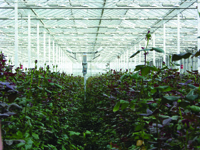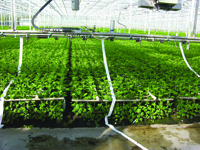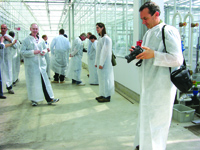
Features
Biocontrols
Inputs
New age biologicals
September 29, 2008 By Graeme Murphy and Gillian Ferguson
Research is continuing to develop more effective controls and applications.
In April of 2008, the International Organization of Biological Control (Greenhouse IPM Working Group) held its regular meeting (every three years) where researchers, extension specialists and industry representatives get together to discuss recent developments in biological control in greenhouse crops. The meeting location varies, with this year’s being held in the picturesque village of Sint Michiels-Gestel in southern Holland.
 |
| Release of predatory mites using a robotic applicator in roses. |
This meeting provides a great opportunity for the discussion of new information on biological pest management in temperate climate greenhouses. Approximately 130 people from 25 countries attended the meeting (13 from Canada), with 64 submitted papers and approximately 50 presentations on a range of topics designed to encourage and stimulate discussion over four days.
Session topics included:
New biocontrol agents.
Alternative food and IPM.
Biocontrol of individual pests (e.g., thrips, mites, whiteflies).
IPM in ornamentals.
Interactions among biocontrol agents.
Microbial control of pests.
IPM in outdoor and hardy nursery stock.
A full day of greenhouse tours highlighted the use of biological control by local growers.
A GLOBAL INDUSTRY WITH STRONG SENSE OF PARTNERSHIP
Research into greenhouse biocontrol around the world is very broad in scope, and one of the nicest aspects is that no matter where the research is done, it is usually applicable in greenhouse production everywhere. It is truly a global industry and there is a very strong sense of partnership in a meeting such as this where everyone recognizes the benefits of working together and sharing information.
Although there were a number of specific topics discussed during the meeting, a number of points emerged as key trends in the world of greenhouse biocontrol research:
The use of predatory mites as a mainstay of biocontrol programs is becoming more obvious. For years predatory mites have been the primary method of control of two-spotted spider mites (Phytoseiulus persimilis) and thrips (Amblyseius cucumeris), but with the recent development of A. swirskii and work since then, more effort is being placed on research into new predatory mites of other pests as well, particularly whitefly. A. swirskii is still receiving a lot of attention, and papers were presented on its use in various vegetable and ornamental crops.
 |
| Mechanical distribution of slow-release sachets containing predatory mites in a chrysanthemum crop. |
NEW PREDATORY MITES DISCUSSED AND COMPARED
A keynote address by Dr. Maurice Sabelis (U of Amsterdam) highlighted this trend by concentrating on the increasing use of predatory mites and their future potential. Several new species (i.e., not yet commercialized) of predatory mites were discussed and compared to those currently on the market. Some of the research suggests that there are promising new developments to come in the next few years.
The second point of note was the attention being paid to the potential use of supplementary food sources as a way to better establish biocontrol populations in the greenhouse, especially in the absence of a pest food source. Dr. Felix Wäckers discussed some of the differences between the nutrit-ional requirements of pests and biocontrol agents (BCAs). In particular, he referred to the needs for nectar and pollen by many parasitic wasps, and the use of the same or similar foods by many of the pests they are trying control. The presentation was built around the idea that biocontrol can be improved if the nutritional needs of the natural enemies are met. This led to discussion on the use of alternative plants (trap plants, banker plants) designed to improve BCA establishment. This is an idea that a number of Ontario growers are currently exploring in their greenhouses. Other speakers presented information on food supplements added to the biocontrol formulations as a means of improving establishment, although much of this work is still preliminary.
Thrips retain their position as a key pest that can make or break a biocontrol program, particularly in ornamental crops. The problem with resistance to insecticides such as spinosad is not restricted to Ontario and the lack of effective alternatives is likewise a common issue. On the positive side, this is providing impetus for increased use of biocontrol in ornamental crops, but there is general concern about increasing thrips problems.
In ornamental crops, the efforts being put into promoting the use of biocontrol seem to be paying off. There was a feeling of greater optimism about its use – increased use plus greater success. The greenhouse tour through a number of facilities, including ornamentals, highlighted the creative use of BCAs in ornamentals and the success that growers are having.
 |
| Graeme Murphy and other participants during a tour of a research centre that focuses on glasshouse studies in the Netherlands. |
Meetings such as this serve to strengthen the ties that exist among those involved in the greenhouse biocontrol industry around the world. Discussion and collaboration are an essential part of maintaining progress in research, and as usual this conference reinforced the importance of sharing information and ideas. Three years seem a long time until the next meeting (in the U.K.), but you can be sure that developments in the intervening period will make the wait worthwhile.
Graeme Murphy and Gillian Ferguson are greenhouse IPM specialists with the Ontario Ministry of Agriculture, Food and Rural Affairs.
Print this page